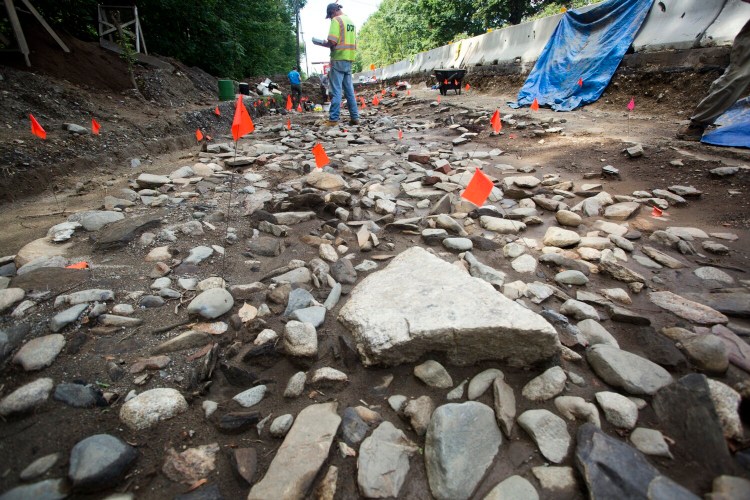Layer by layer, archaeologists in Windham are resolving – and revealing – mysteries.

An 18th-century piece of tin-glazed porcelain was found at the site of the fort that’s being unearthed along River Road in Windham. Derek Davis/Staff Photographer Buy this Photo
The questions they have as they sift through nearly three centuries of dirt and rubble include how a 1744-era fort was constructed, how many people sought refuge in it and what life was like for the colonists who had moved to the area from Marblehead, Massachusetts.
John Mosher and his team from the Maine Historic Preservation Commission have to work fast to find answers. Their excavation is being done alongside River Road in Windham, which is being rebuilt by the Maine Department of Transportation.
On Tuesday, the archaeologists will wrap up work on the west side of the road and move to the east side, where they will have another month or so to excavate and examine the remains of the fort.
After that, construction crews will lower the hilltop road about 5 feet and rebuild and widen the pavement. Whatever is left of the fort is likely to be trucked from the site.
Most of the site consists of clusters of rock, which Mosher said is evidence of chimney foundations and a base for a wooden boardwalk inside the fort. The archaeologists are unsure of the reason for another large cluster of rocks on the site, he said, but hope that the excavation of the rest of the fort might provide an answer.
The only artifacts found from the period when the fort existed, he said, were gun flints and small pieces of ceramics.

The area around the fort was called New Marblehead by the 60 or so colonists from Massachusetts who had been granted a large tract of land to settle west of Portland. Province Fort was built on a hilltop near the center of the settlement, and close to the Presumpscot River, as hostilities were growing between English colonists, like those from Massachusetts, and Native Americans, who were allies of the French.
The hostilities eventually grew into King George’s War, which was fought between 1744 and 1748, primarily in upstate New York, New England and Nova Scotia. The war did little to resolve the territorial ambitions of the British and the French, or the status of the Native Americans in the Northeast and eastern Canada.
Province Fort was used mainly as a refuge for the settlers, Mosher said. Records indicate it was a square that was roughly 50 feet by 50 feet, but it may have been larger, Mosher said, and was surrounded by a palisade of posts with a gate. Colonists would rush to the safety of the fort in case of attack. A block house was constructed inside the fort walls, he said, and archaeologists are trying to determine if there were other structures as well, which would indicate that large numbers of settlers might have spent significant time inside the fort.

Sarah Loftus of the Northeast Archaeology Research Center works with the team of state archaeologists Thursday at the Province Fort dig site in Windham. Derek Davis/Staff Photographer Buy this Photo
After hostilities eased, Mosher said, the fort became the center of town, getting used for meetings, and a church and the minister’s house were located nearby. The fort was eventually sold in 1782 and the new owner deconstructed it and used the timbers for other purposes.
That leaves Mosher and his team with clues, but not many concrete facts, to go on, he said.
“It becomes really complicated,” he said. “But it’s a fun puzzle. Every day we tend to generate more questions than answers.”
Mosher said a lot of the work involves taking pictures of the site that can be analyzed later. The artifacts collected, he said, also will be analyzed and catalogued over the winter.

Sarah Loftus of the Northeast Archaeology Research Center works Thursday at the Province Fort dig site in Windham. Records suggest that the fort was a square roughly 50 feet by 50 feet. Derek Davis/Staff Photographer Buy this Photo
They had to be sorted carefully, he said, because residents apparently dumped a fair amount of rubbish on the site and archaeologists found items from as recent as the 1920s.
Archaeologists knew for years that the fort was somewhere in the area, Mosher said, but weren’t able to confirm it until three years ago, when they dug test holes alongside River Road and found signs of the structure. The road project is getting some federal funds, he said, and rules require the state to take steps to preserve or allow exploration of archaeological and architecturally significant sites when federal money is involved.
Susan Simonson, president of the Windham Historical Society, said town members had heard rumors that there was a fort in the area and she is gratified that the Historic Preservation Commission’s work proves its existence and provides more details about the fort. However, she also said it’s “disheartening” to know that, in the end, the fort’s remains will be removed and the site covered over.
“It would be really nice to preserve it,” she said.
Send questions/comments to the editors.




Success. Please wait for the page to reload. If the page does not reload within 5 seconds, please refresh the page.
Enter your email and password to access comments.
Hi, to comment on stories you must . This profile is in addition to your subscription and website login.
Already have a commenting profile? .
Invalid username/password.
Please check your email to confirm and complete your registration.
Only subscribers are eligible to post comments. Please subscribe or login first for digital access. Here’s why.
Use the form below to reset your password. When you've submitted your account email, we will send an email with a reset code.